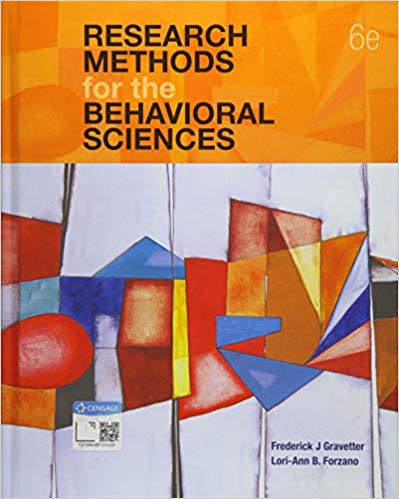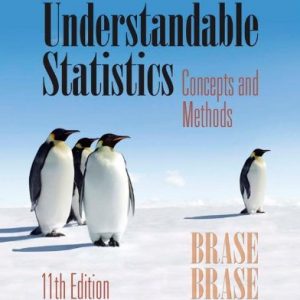Instant download Solution Manual for Research Methods for the Behavioral Sciences 6th Edition digital download immediately after payment is complete pdf docx epub after payment.

Product details:
- ISBN-10 : 1337613312
- ISBN-13 : 978-1337613316
- Author:
Table of contents:
- Chapter 1: Introduction, Acquiring Knowledge, and the Scientific Method
- Chapter Learning Objectives
- Chapter Overview
- 1.1 Methods of Knowing and Acquiring Knowledge
- 1.2 The Scientific Method
- 1.3 The Research Process
- Chapter Summary
- Key Words
- Exercises
- Learning Check Answers
- Chapter 2: Research Ideas and Hypotheses
- Chapter Learning Objectives
- Chapter Overview
- 2.1 Getting Started: Identifying a Topic Area
- 2.2 Searching the Existing Research Literature in a Topic Area
- 2.3 Finding an Idea for a Research Study from a Published Research Article
- 2.4 Using a Research Idea to Form a Hypothesis and Create a Research Study
- Chapter Summary
- Key Words
- Exercises
- Learning Check Answers
- Chapter 3: Defining and Measuring Variables
- Chapter Learning Objectives
- Chapter Overview
- 3.1 Constructs and Operational Definitions
- 3.2 Validity and Reliability of Measurement
- 3.3 Scales of Measurement
- 3.4 Modalities of Measurement
- 3.5 Other Aspects of Measurement
- Chapter Summary
- Key Words
- Exercises
- Learning Check Answers
- Chapter 4: Ethics in Research
- Chapter Learning Objectives
- Chapter Overview
- 4.1 Introduction
- 4.2 Ethical Issues and Human Participants in Research
- 4.3 Ethical Issues and Nonhuman Subjects in Research
- 4.4 Ethical Issues and Scientific Integrity
- Chapter Summary
- Key Words
- Exercises
- Learning Check Answers
- Chapter 5: Selecting Research Participants
- Chapter Learning Objectives
- Chapter Overview
- 5.1 Introduction to Sampling
- 5.2 Probability Sampling Methods
- 5.3 Nonprobability Sampling Methods
- Chapter Summary
- Key Words
- Exercises
- Learning Check Answers
- Chapter 6: Research Strategies and Validity
- Chapter Learning Objectives
- Chapter Overview
- 6.1 Research Strategies
- 6.2 External and Internal Validity
- 6.3 Threats to External Validity
- 6.4 Threats to Internal Validity
- 6.5 More about Internal and External Validity
- Chapter Summary
- Key Words
- Exercises
- Learning Check Answers
- Chapter 7: The Experimental Research Strategy
- Chapter Learning Objectives
- Chapter Overview
- 7.1 Cause-and-Effect Relationships
- 7.2 Distinguishing Elements of an Experiment
- 7.3 Controlling Extraneous Variables
- 7.4 Control Conditions and Manipulation Checks
- 7.5 Increasing External Validity: Simulation and Field Studies
- Chapter Summary
- Key Words
- Exercises
- Learning Check Answers
- Chapter 8: Experimental Designs: Between-Subjects Design
- Chapter Learning Objectives
- Chapter Overview
- 8.1 Introduction to Between-Subjects Experiments
- 8.2 Individual Differences as Confounding Variables
- 8.3 Limiting Confounding by Individual Differences
- 8.4 Individual Differences and Variability
- 8.5 Other Threats to Internal Validity of Between-Subjects Experimental Designs
- 8.6 Applications and Statistical Analyses of Between-Subjects Designs
- Chapter Summary
- Key Words
- Exercises
- Learning Check Answers
- Chapter 9: Experimental Designs: Within-Subjects Design
- Chapter Learning Objectives
- Chapter Overview
- 9.1 Within-Subjects Experiments and Internal Validity
- 9.2 Dealing with Time-Related Threats and Order Effects
- 9.3 Comparing Within-Subjects and Between-Subjects Designs
- 9.4 Applications and Statistical Analysis of Within-Subjects Designs
- Chapter Summary
- Key Words
- Exercises
- Learning Check Answers
- Chapter 10: The Nonexperimental and Quasi-Experimental Strategies: Nonequivalent Group, Pre-Post, an
- Chapter Learning Objectives
- Chapter Overview
- 10.1 Nonexperimental and Quasi-Experimental Research Strategies
- 10.2 Between-Subjects Nonexperimental and Quasi-Experimental Designs: Nonequivalent Group Designs
- 10.3 Within-Subjects Nonexperimental and Quasi-Experimental Designs: Pre-Post Designs
- 10.4 Developmental Research Designs
- 10.5 Applications, Statistical Analysis, and Terminology for Nonexperimental, Quasi-Experimental, an
- Chapter Summary
- Key Words
- Exercises
- Learning Check Answers
- Chapter 11: Factorial Designs
- Chapter Learning Objectives
- Chapter Overview
- 11.1 Introduction to Factorial Designs
- 11.2 Main Effects and Interactions
- 11.3 Types of Factorial Designs and Analysis
- 11.4 Applications of Factorial Designs
- Chapter Summary
- Key Words
- Exercises
- Learning Check Answers
- Chapter 12: The Correlational Research Strategy
- Chapter Learning Objectives
- Chapter Overview
- 12.1 An Introduction to Correlational Research
- 12.2 The Data and Statistical Analysis for Correlational Studies
- 12.3 Applications of the Correlational Strategy
- 12.4 Strengths and Weaknesses of the Correlational Research Strategy
- Chapter Summary
- Key Words
- Exercises
- Learning Check Answers
- Chapter 13: The Descriptive Research Strategy
- Chapter Learning Objectives
- Chapter Overview
- 13.1 An Introduction to Descriptive Research
- 13.2 The Observational Research Design
- 13.3 The Survey Research Design
- 13.4 The Case Study Design
- Chapter Summary
- Key Words
- Exercises
- Learning Check Answers
- Chapter 14: Single-Case Experimental Research Designs
- Chapter Learning Objectives
- Chapter Overview
- 14.1 Introduction
- 14.2 Phases and Phase Changes
- 14.3 Reversal Designs: ABAB and Variations
- 14.4 Multiple-Baseline Designs
- 14.5 General Strengths and Weaknesses of Single-Case Designs
- Chapter Summary
- Key Words
- Exercises
- Learning Check Answers
- Chapter 15: Statistical Evaluation of Data
- Chapter Learning Objectives
- Chapter Overview
- 15.1 The Role of Statistics in the Research Process
- 15.2 Descriptive Statistics
- 15.3 Inferential Statistics
- 15.4 Finding the Right Statistics for Your Data
- 15.5 Special Statistics for Research
- Chapter Summary
- Key Words
- Exercises
- Learning Check Answers
- Chapter 16: Writing an APA-Style Research Report
- Chapter Learning Objectives
- Chapter Overview
- 16.1 The Goal of a Research Report
- 16.2 General APA Guidelines for Writing Style and Format
- 16.3 The Elements of an APA-Style Research Report
- 16.4 Writing a Research Proposal
- Chapter Summary
- Key Words
- Exercises
- Learning Check Answers
- Appendices
- Glossary
- References
- Name Index
- Subject Index
People also search:
Research Methods for the Behavioral Sciences 6th Edition
Research Methods for the Behavioral Sciences 6th Edition pdf
Research Methods for the Behavioral Sciences
|
research methods in the behavioral sciences |





